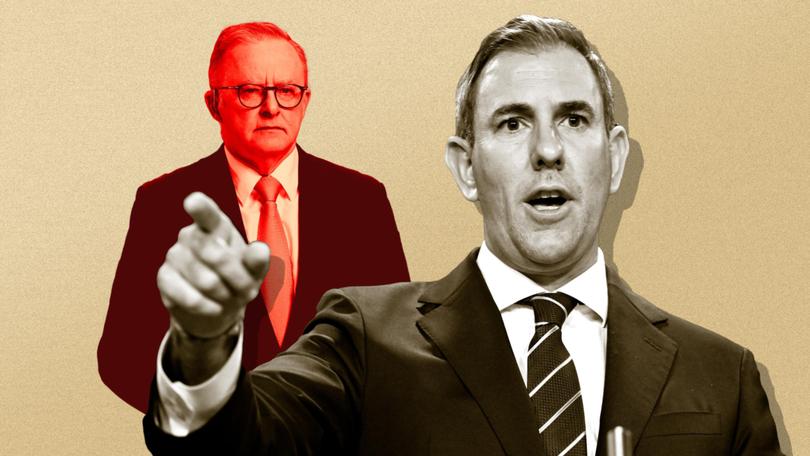JACKSON HEWETT: Australia goes backwards as interest rates reset to a higher base

After driving through eleven Treasury-related bills during this week’s version of Parliamentary whack-a-mole, Jim Chalmers took a moment to congratulate himself.
“Tax reform, housing, super objective, Future Made in Australia, consumer protections in buy now, pay later, competition policy, getting a better deal for people at the checkout, and the Reserve Bank reforms as well,” he rattled off.
“This is what progress and delivery looks like. We’ve been able to focus primarily on the cost of living and the fight against inflation, at the same time as we keep the wheels of economic reform turning.”
Sign up to The Nightly's newsletters.
Get the first look at the digital newspaper, curated daily stories and breaking headlines delivered to your inbox.
By continuing you agree to our Terms and Privacy Policy.He’ll need a hell of a lot those reforms to make a material difference to ordinary Australians if they are to give Labor a fair shot at the next election.
Most are looking for rate relief.
And as the news keeps coming that a rate cut here is being pushed back, other countries around the world are enjoying mortgage relief.
This week New Zealand put through a jumbo half a per cent cut and promised more to come next year. The US Federal Reserve and the European Central Bank have cut rates by three-quarters of a per cent this year. All three central banks had jacked interest rates higher than the RBA.
The fact that rates are being cut across the ditch and elsewhere is sticking in the throat of indebted households, who continue to scrimp with every available cent.
Australia is looking further and further off the pace with international peers, with household disposable income per capita continuing to sink, and showing Australians are worse off than before the pandemic. By contrast, the US continues to power ahead, as does most of the OECD.
In Australia we prevented short term pain by not raising rates as high to preserve what now look like zombie jobs, by using migration to bump up GDP at the expense of housing, and failing to rein in excessive government spending on programs like the NDIS.
Young people have particularly copped it in the neck, with 18-29 year olds cutting back on spending more than any other group, while young families 30-39 have also reduced their spend, according to Commbank.
By contrast, the over 60s are whistling dixie, increasing spending by 4 per cent, and more than 7 per cent for the over 70s.
Chalmers reforms are going to come way too late for the youth cohort doing it tough, which is why the Government is talking up programs that will take years to come to fruition.
More power to regulators in terms of mergers and acquisitions may increase competition but our economy is possibly too small to support more than the current oligopolies, and while the supermarket inquiry wants to find a smoking gun on prices, it likely won’t. The promised new houses won’t be available until well after the next election.
Even the social media ban is 12 months away which means teens won’t be off TikTok in time to fill the part time jobs that were being filled by temporary migrants.
End of a rates era
It’s a bleak outlook for young Australians, made worse by new research by Westpac that suggests the world is about to enter a space where interest rates will be materially higher than before the pandemic, while wages stay relatively stagnant.
According to Westpac economist and former Reserve Bank assistant governor Luci Ellis and her colleague Pat Bustamante, we are about to enter an era where higher government spending on the net-zero transition, defence and an ageing population is going to suck up capital at a time when the private sector is heavily spending on the digital economy.
Hundreds of billions of dollars are going toward building energy hungry data centres, and the demand for artificial intelligence means that reinvestment in new banks of chips must occur every year.
Westpac is already seeing those investments showing up Australia’s capital expenditure figures. But something interesting is also showing up. Increasingly, capital expenditure is on so-called intangibles like software.
This is important in two ways, Ellis says.
First, the changing technology mix is not historically beneficial to employees. In the first wave of software adoption, the change in skills needed “lowered the bargaining power of workers and shifted some of the share of income from production away from wages towards profits.”
A faster rate of technological change, as we are seeing with AI-related investments, means a “faster rate of churn in the kinds of jobs available.” That does not sound promising for wage rises going forward.
At the same time, the rapid depreciation of technology like data centres is going to require lots of capital to replace it in a relatively short amount of time. Where once machinery for manufacturing would have a 20 year lifespan, these technologies need to be replaced in two and a half years.
That means that as governments are facing the long and large costs of the energy transition, defence and the ageing population, businesses will be competing for capital to fund the current technological tsunami that is AI.
It adds up to higher long-term interest rates in Ellis’s view, as the savings pool will not be large enough to fund all the new investment.
“That period (of the GFC to the pandemic) which was a period of a very low interest rate structure, is just no more,” Ellis says. She expects that central banks will reset rates to nearer to three per cent and bond rates above four per cent. After a decade where rates were much, much lower the world must “plan for the fact that the global rate structure is higher, and there’ll be some projects that would have been economic five, 10 years ago that won’t be economic.”
That has implications for householders, for share markets and for governments who will need to adapt to a world where higher interest rates reduces long term borrowing capacity, lower company valuations and force governments to more carefully consider how they borrow and spend.
Might be a good time for Jim Chalmers to hand the problem over to someone else.

